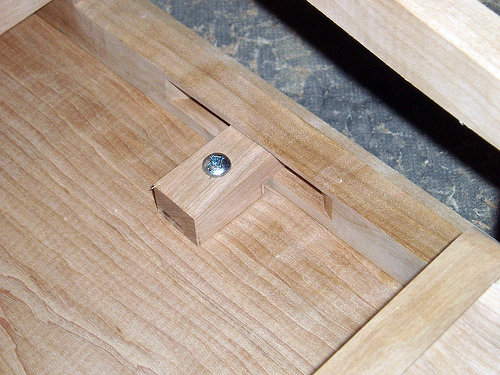
Designing for Wood Movement, Part 2: Using Cleats or Buttons to Attach a Tabletop
Get into the groove
In the last entry we saw a builder create a tabletop the wrong way. By not obeying the rules of wood movement, the builder has doomed the tabletop to failure.
The rule that the builder ought have followed is a simple one: Design for boards to expand and contract along their width. A competent designer/builder never traps a piece of wood within a four-sided frame.
For centuries, builders have known how to attach tabletops in such a way that they will not lift up off of the base, yet can still expand and contract freely. Their trick is simple, which is to use slots and cleats (also called buttons). This system not only allows the tabletop to move around, but also keeps it flat.
 Image via Blake
Image via Blake The cleats/buttons are simple and can be made from cut-offs. Take care to ensure the grain is aligned properly.
 Ganging up production. (Image via Popular Woodworking)
Ganging up production. (Image via Popular Woodworking) The tabletop is screwed directly to the apron at only two points, both along the centerline of the tabletop's width. With this being the only fixed point, when the tabletop expands or contracts, the overhangs will still be even on both sides.
 Image by Canadian Woodworking
Image by Canadian Woodworking The cleats are each screwed directly into the tabletop with a single screw. Pay attention when making the cleat to ensure the grain is running in the correct direction, so that you don't have to worry about the cleat expanding too.
The tongue of the cleat fits into slots or a continuous groove cut into the inside of the apron.
 Image via Blake
Image via Blake The cleats that are placed at the short ends of the table can slide freely from side-to-side in the groove, or a slot that has been cut wider than the tongue to leave room for this.
The cleats placed along the long edges of the table should have their tongues sized so that there is room for them to travel deeper into the groove when the tabletop expands, and can withdraw, without popping out, when the tabletop shrinks.
 Image via Woodcraft
Image via Woodcraft  Image via Woodcraft
Image via Woodcraft These days there is also a variety of metal hardware you can buy that will perform the same trick as a cleat. Search the web and you'll find plenty. Here are a couple of examples:
 Enter a caption (optional)
Enter a caption (optional) Enter a caption (optional)
Enter a caption (optional)If you don't want to cut grooves or slots and prefer to use a drill press and a Forstner bit, an alternative is Rockler's Figure 8 Desktop Fasteners.
 Enter a caption (optional)
Enter a caption (optional)Here's a video on how to install them:
Cutting the Grooves or Slots
Whether you cut a continuous groove or a slot depends on which tool you have or prefer to use: Circular saw, table saw, router, Festool Domino, a drill press and a lot of patience, or a chisel. Cutting these slots or grooves prior to assembly is obviously the most efficient, and if something goes awry during assembly--let's say you have to correct for a mis-cut joint and now have to plane the tops of some of the aprons a bit to get them all level, which then means your slots are closer to the tabletop on those modified aprons--it's then easy enough to simply re-cut a wooden cleat to the correct height.
However, this gentleman below takes a different approach, and cuts the slots after assembly using a router and a rabbeting bit:
So that's just a reminder that you don't have to be locked into a single way of doing this. You can decide what works best for you, your process, your design, and the tools you own.
Pro Tip
Slightly off-topic but relevant: If you're building a table for a client and delivering it yourself, you may be transporting it with the tabletop and base unattached, as it's easier to get through doorways and such. Here's a pro tip from designer/builder Peter Dettorre on figuring out the alignment beforehand in your shop, so you're not futzing around too much on-site:
Next we'll look at the technique a competent builder would use to avoid the horrific wood movement issues seen here.
-
o3Favorite This
-
QComment
K
{Welcome
Create a Core77 Account
Already have an account? Sign In
By creating a Core77 account you confirm that you accept the Terms of Use
K
Reset Password
Please enter your email and we will send an email to reset your password.

